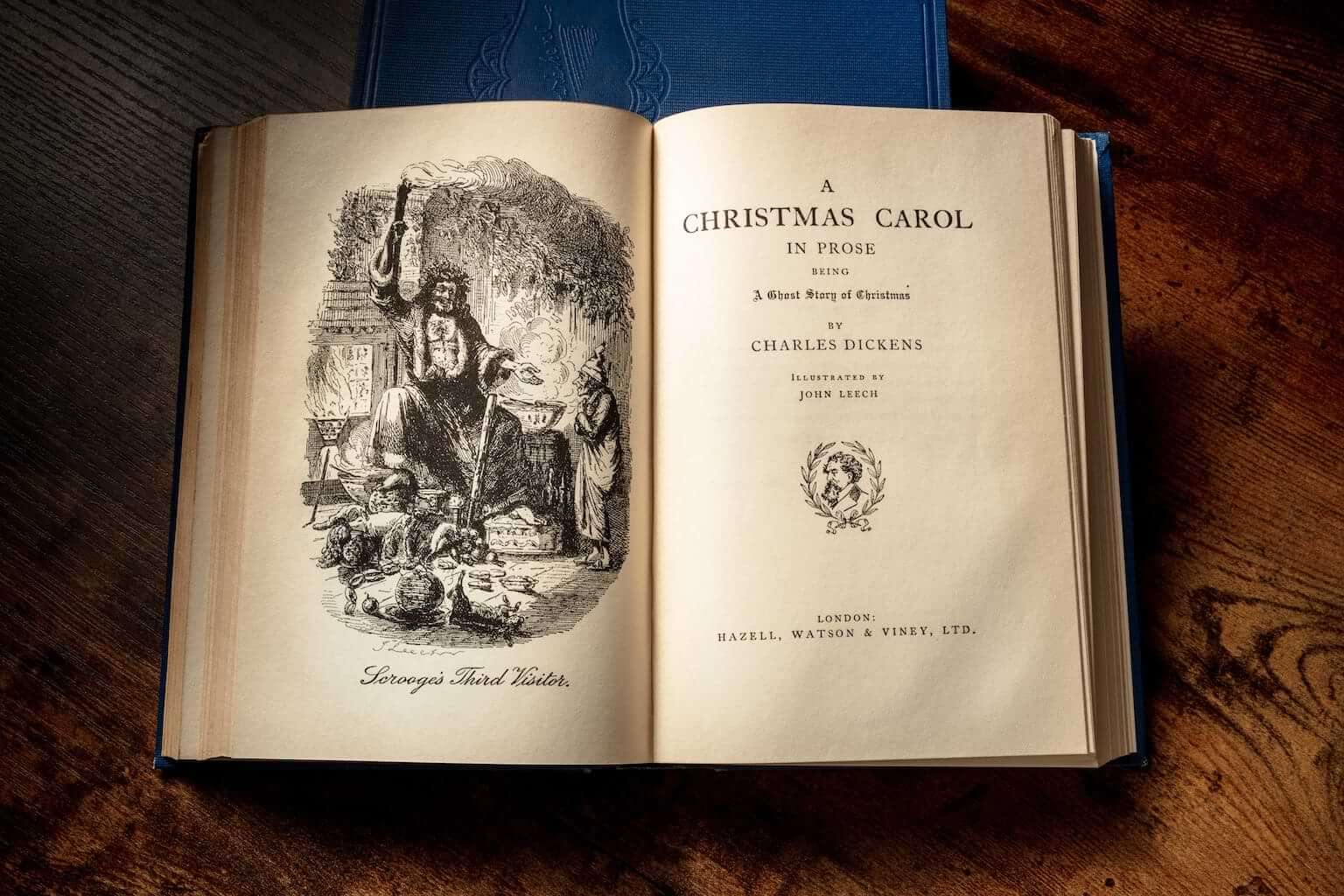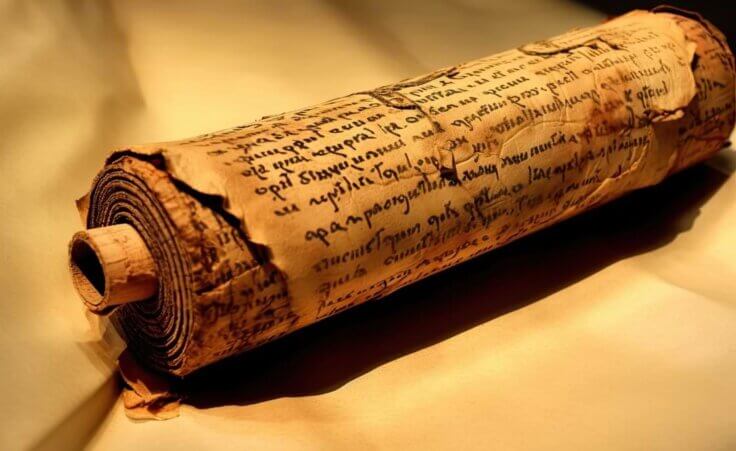
Charles Dickens' book "A Christmas Carol" lies open featuring an illustration of "Scrooge's Third Vistor" on the left page and the title page on the right. By laplateresca/stock.adobe.com
“A Christmas Carol” was published on this day in 1843. As everyone knows, Charles Dickens’ classic tale portrays Ebenezer Scrooge as he discovers the consequences of his miserly ways for others and ultimately for himself. Given an opportunity to repent, he becomes a gracious and charitable servant of all.
Here’s what I only recently learned: Dickens’ story was born in part out of his own experiences.
His father was a clerk in the navy pay office in England but was thrown into debtors’ prison in 1824. The twelve-year-old Charles was then sent to work in a factory, where he witnessed firsthand the miserable treatment of children in such conditions. His personal experience with poverty marked him and became a theme of many of his novels.
I found his story relevant as it illustrates two incarnational miracles we do well to remember and celebrate this week.
How to “get the hang” of Christmas
Travel with me to the present-day town of Bethlehem. Here we make our way to the Church of the Nativity, the oldest church in Christian history. We bow to step through the Door of Humility, constructed centuries ago to keep marauders from riding horseback into the church, and into the magnificent Greek Orthodox cathedral. We make our way to the right of the platform and climb down a set of ancient stone steps into the cave below.
Here we find the place marked by tradition as the spot where Jesus was born. He was the only baby to choose his parents, and he chose not royalty but peasants. The only baby to choose his attendants, and he chose not priests and rabbis but dirty field hands. The only baby to choose the place of his birth, and he chose not a palace in Jerusalem but an animal stable in Bethlehem.
What’s more, this baby made the world he entered: “By him all things were created, in heaven and on earth, visible and invisible, whether thrones or dominions or rulers or authorities—all things were created through him and for him” (Colossians 1:16). What’s even more, he entered not just our broken world but our fallen bodies: “The Word became flesh and dwelt among us” (John 1:14).
C. S. Lewis explained the incarnation this way:
The Second Person in God, the Son, became human himself; was born into the world as an actual man—a real man of a particular height, with hair of a particular color, speaking a particular language, weighing so many stone. The Eternal Being, who knows everything and who created the whole universe, became not only a man but (before that) a baby, and before that a fetus inside a woman’s body.
If you want to get the hang of it, think how you would like to become a slug or a crab.
If Jesus would be born in that Bethlehem stable, he will be born again anywhere—even in your heart and mine.
This is the first incarnational miracle of Christmas: that the Christ would leave his glory for our lowliness, choosing, as Irenaeus noted, to become one of us that we might be one with him.
The humility of Christmas shows us that anyone can come to God through Christ (Galatians 3:28). If shepherds and peasants were welcome, we are welcome. The ground is level at the side of the manger and the foot of the cross.
Born as a human to die for humans
This fact leads us to a second observation: this baby was born to die.
We all begin dying from the moment we are conceived. None of us will live forever in these fallen bodies. However, no one but Christ was born for the purpose of dying. None but the Child of Christmas came into the world to die for the world.
No other figure in human history attempted to do such a vicarious thing. No Buddha, Confucius, or Mohammad ever claimed to die for humanity. The reason is simple: no human but Jesus had the capacity to do so. Since the debt owed by sin is death (Romans 6:23), and every person except Christ is a sinner, each of us can by our death pay only our own debt. It took a sinless Savior to die for our sins since he had none of his own for which to atone.
And this is precisely what Jesus came into the world to do as “the Lamb who was slain from the creation of the world” (Revelation 13:8 NIV). This was precisely what his Father sent him to do: “God shows his love for us in that while we were still sinners, Christ died for us” (Romans 5:8). It was what the Father chose as he watched his Son die on our cross to pay for our sins.
And it was what Jesus chose as well. No other human made the choice to be born at all, but Jesus chose to be born as a human so he could die for humans.
Here is the second incarnational miracle of Christmas: that the Father and the Son love us so much that they conspired to pay the debt we owed so we could spend eternity in paradise.
As the most famous verse in Scripture proclaims, “God so loved the world, that he gave his only Son, that whoever believes in him should not perish but have eternal life” (John 3:16).
“This, this is Christ the King”
The sacrificial humility and atoning purpose of Christmas are easily lost in a season that ironically focuses on precisely the opposite. Each year it seems that the glamour and consumerism of the holidays grow. And each year, we become more irreligious and more depressed than ever in our nation’s history.
Could these facts be related?
Let’s take time across these days to kneel in the manger of our hearts before the extravagance of Christmas grace. Let’s pause to reflect on the crucified suffering of Christmas love. Let’s embrace the fact that Jesus would do it all over again, just for us.
Then let’s share the incarnational miracles of Christmas with those we serve so they can join us in wondrous worship and grateful service.
What Child is this, who, laid to rest,
On Mary’s lap is sleeping?
Whom angels greet with anthems sweet,
While shepherds watch are keeping?Why lies he in such mean estate,
Where ox and ass are feeding?
Good Christian, fear: for sinners here
The silent Word is pleading.So bring him incense, gold, and myrrh,
Come, peasant, king to own him.
The King of kings salvation brings;
Let loving hearts enthrone him.This, this is Christ, the King,
Whom shepherds guard and angels sing:
Haste, haste to bring him laud,
The Babe, the Son of Mary!













